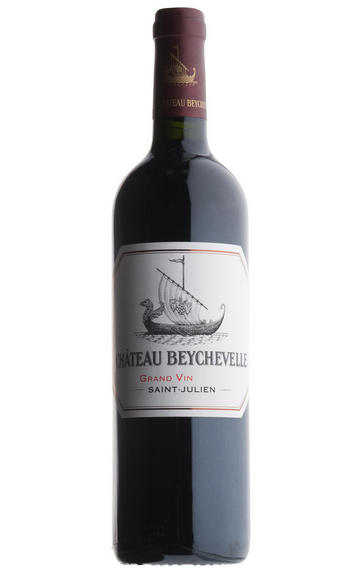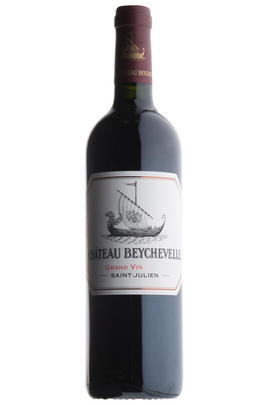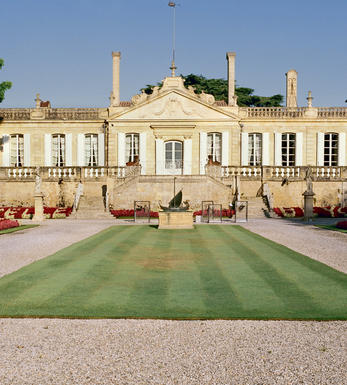
2010 Château Beychevelle, St Julien, Bordeaux

Critics reviews
Robert M. Parker, Jr. - 28/02/2013
Jancis Robinson MW- jancis robinson.com, Apr 2011
James Molesworth – The Wine Spectator – Mar 2011
94 Robert Parker- Wine Advocate- Feb 2013
Flowery blueberry, red and black currant fruit notes intermixed with a hint of damp earth emerge from this wine’s moderate aromatics. Elegant with medium body as well as a classic Beychevelle style with high tannins and a more restrained structure, the elevated tannins suggest 7-8 years of cellaring will be necessary.
90-92 Robert Parker- Wine Advocate- May 2011
About this WINE

Chateau Beychevelle
Château Beychevelle is a 4ème Cru Classé St-Julien wine property that boasts one of the most impressive châteaux in the whole of the Médoc. Its label depicts a beautiful galley with a large sail, as a consequence of its ownership in the 16th century by the Duc d`Eperon, Admiral of France at the time. The expression "Baisse-Vaille", meaning "lower sails", later evolved into the name Beychevelle. Today the property is owned by Grands Millésimesde France.
Beychevelle's 85 hectares of vineyards are located in the far south of the St-Julien appellation, just outside the hamlet of St-Julien-Beychevelle. The wine is typically a blend of 60% Cabernet Sauvignon, 28% Merlot, 8% Cabernet Franc and 4% Petit Verdot. It is matured in oak barrels (50-60% new) for 18 months. It is renowned for its suppleness, smoothness and its rich, and sometimes chocolatey character.
The best examples from the best Beychevelle vintages are powerful and concentrated, with oodles of almost sweet, ultra-ripe Cabernet fruit, and can age effortlessly.

St Julien
St Julien is the smallest of the "Big Four" Médoc communes. Although, without any First Growths, St Julien is recognised to be the most consistent of the main communes, with several châteaux turning out impressive wines year after year.
St Julien itself is much more of a village than Pauillac and almost all of the notable properties lie to its south. Its most northerly château is Ch. Léoville Las Cases (whose vineyards actually adjoin those of Latour in Pauillac) but, further south, suitable vineyard land gives way to arable farming and livestock until the Margaux appellation is reached.
The soil is gravelly and finer than that of Pauillac, and without the iron content which gives Pauillac its stature. The homogeneous soils in the vineyards (which extend over a relatively small area of just over 700 hectares) give the commune a unified character.
The wines can be assessed as much by texture as flavour, and there is a sleek, wholesome character to the best. Elegance, harmony and perfect balance and weight, with hints of cassis and cedar, are what epitomise classic St Julien wines. At their very best they combine Margaux’s elegance and refinement with Pauillac’s power and substance.
Ch. Léoville Las Cases produces arguably the most sought-after St Julien, and in any reassessment of the 1855 Classification it would almost certainly warrant being elevated to First Growth status.
Recommended Châteaux: Ch. Léoville Las Cases, Ch.Léoville Barton, Ch Léoville Poyferré, Ch. Ducru-Beaucaillou, Ch Langoa Barton, Ch Gruaud Larose, Ch. Branaire-Ducru, Ch. Beychevelle

Cabernet Sauvignon Blend
Cabernet Sauvignon lends itself particularly well in blends with Merlot. This is actually the archetypal Bordeaux blend, though in different proportions in the sub-regions and sometimes topped up with Cabernet Franc, Malbec, and Petit Verdot.
In the Médoc and Graves the percentage of Cabernet Sauvignon in the blend can range from 95% (Mouton-Rothschild) to as low as 40%. It is particularly suited to the dry, warm, free- draining, gravel-rich soils and is responsible for the redolent cassis characteristics as well as the depth of colour, tannic structure and pronounced acidity of Médoc wines. However 100% Cabernet Sauvignon wines can be slightly hollow-tasting in the middle palate and Merlot with its generous, fleshy fruit flavours acts as a perfect foil by filling in this cavity.
In St-Emilion and Pomerol, the blends are Merlot dominated as Cabernet Sauvignon can struggle to ripen there - when it is included, it adds structure and body to the wine. Sassicaia is the most famous Bordeaux blend in Italy and has spawned many imitations, whereby the blend is now firmly established in the New World and particularly in California and Australia.


Buying options
Add to wishlist
Description
There will be many ‘yin and yang’ statements made this year, with commentators and châteaux owners alike comparing last year with this, and nowhere is this more present and true than at Ch. Beychevelle. 2009 is soft, warm and seductive and 2010 is firm, serious, yet totally beguiling. The 2009 will drink a lot younger than the 2010 but I have a serious hunch that the 2010 will ultimately give you more. Bravo Philippe, an awe-inspiring brace from Beychevelle.
(54% Cabernet Sauvignon, 38% Merlot, 6% Cabernet Franc. 14.3%abv)
Simon Staples, Fine Wine Director
wine at a glance
Delivery and quality guarantee